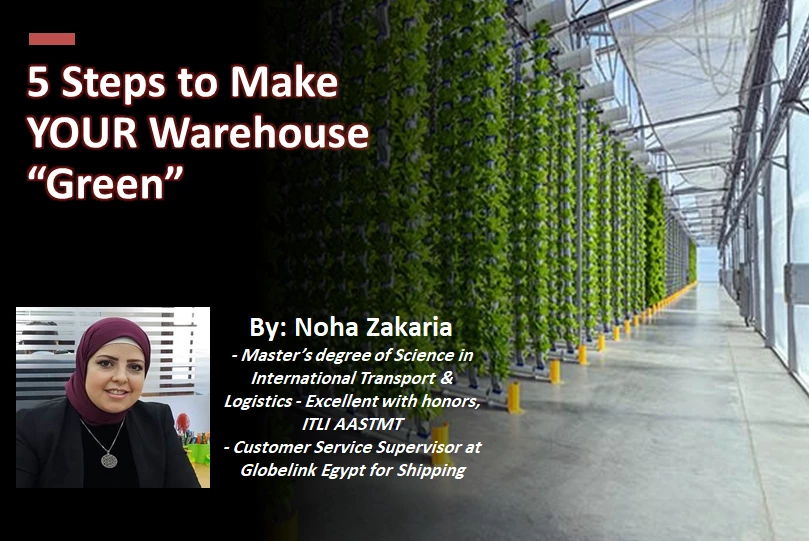
ITLI Listicle Articles | 5 Steps to Make YOUR Warehouse Green
Written By: Noha Zakaria
- Master’s degree of Science in International Transport & Logistics - Excellent with honors, ITLI AASTMT
- Customer Service Supervisor at Globelink Egypt for Shipping
Editor: Dr. Mahmoud Mansi
1- The Lighting energy and carbon reduction.
It has been discovered by the researchers that the biggest expense in a warehouse is the lighting, which can be as much as 65 percent of operating costs.
Intelligent lighting (using sensors) can be incorporated into the lighting system, resulting in as much as a 10 percent decrease in lighting power consumption.
This type of system monitors the available daylight and the occupancy in the building to determine whether lighting should be turned on and how much brightness is required.
Fluorescent lighting is more energy efficient than traditional light bulbs. And if you are willing to pay the extra expense, LED lighting is the most efficient option available.
The technology for LED lighting is moving quickly, so prices may come down in the next few years. Installing lights closer to the work areas will also reduce the amount of lighting required.
2- Bring In An HVAC Specialist.
Another excellent way to increase energy efficiency, is to bring in an HVAC specialist to audit the current heating and cooling capabilities. Not only will their guidance go a long way in sustainability, but due to the large open spaces found within your warehouse, their solutions can save a significant amount in utility expenses. The suggestions they recommend could include everything from upgrading the HVAC system, staying on top of your maintenance, improving insulation, installing ceiling fans, and finding solutions to keep in/out the seasonal air when warehouse doors are open—such as doc shelters.
3- Go Vertical and Build Up instead of Out.
Another thing to keep in mind as the warehouse continues to grow and expand, we have to look for equipment and practices that allow you to go vertical. By building your warehouse “up” instead of out, we will be able to put off expanding to a larger warehouse because you are maximizing the space we already have.
4- Upgrade To Energy Efficient Equipment For Material Handling.
Depending on the type of warehouse owned or managed, we are sure to operate an array of equipment that run on either petroleum or electricity.
As equipment needs to be replaced, look for options that are more energy efficient and pay particular attention to how many gallons per mile, gallons per hour, or how much wattage each item utilizes.
Upgrading to energy efficient alternatives does not mean that we need to sacrifice the capability of our equipment, just that we are more mindful about their efficiency.
5- Reduce, Reuse, and Recycle.
Reduce: It is rare that you’ll find a warehouse that doesn’t already have a cardboard baler to reduce the volume of recyclables. However, the use of cardboard boxes can be reduced by replacing them with metal or plastic containers that can be used, cleaned, and used again, lowering both material intake and operational costs.
Reuse: The disposable one- or two-use stringer pallet has given way to reusable block or plastic pallets. Since these pallets have a much longer lifespan, companies don’t have to keep purchasing new pallets—and be party to excessive timber harvests—to keep operating. Wood block pallets will last 15-20 trips through the supply chain, while high-quality plastic pallets are able to make 80-100 trips.
Recycle: The advantage of sturdier materials like metal and plastic is that when they’ve become too worn to continue operations they can be melted down or reground and returned to use, lessening the environmental costs of harvesting and reducing landfill space. Scrap metal companies will often compensate a business for its unwanted metal, and plastic products can be ground down and reformed into other items including pallets.
To achieve maximum success, do not attempt to tackle all of these green changes at once. Instead, create a schedule for which your green changes will be implemented one or two at a time. By spreading out changes over a period of time, you allow your team the time required to fully develop their new habits and opposed to making so many changes that they are challenging to recall or stay on top of. Most of the green changes you make in your warehouse will all require an upfront cost and investment in time, but will pay for themselves time and time again.
To know more about the academic and professional programs of the International Transport and Logistics Institute (ITLI), please visit the following:
Webpage | LinkedIn | Facebook | Instagram


